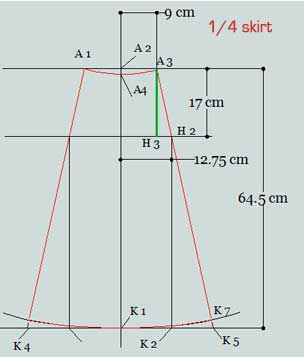A Gored Skirt
How to knit or crochet it
A gore skirt is constructed from triangular panels, known as gores, that are sewn together to create a flared or flowing silhouette.
When made using knitting techniques, a gore skirt can be a comfortable and versatile addition to any wardrobe. By following a few basic steps, you can create a stylish knit gore skirt that is customized to your individual style and body shape.
With the right materials, tools, and techniques, a gore skirt can be a fun and rewarding project for intermediate to advanced knitters.
A gore skirt is a type of skirt that is made up of several triangular or trapezoidal-shaped panels of fabric called gores. The gores are cut in a way that allows the skirt to flare out gradually from the waist to the hem, creating a flowy and flattering silhouette.
Gore skirts have been popular since the Victorian era, and are still commonly worn today in a variety of styles and lengths. They can be made from a range of fabrics, including cotton, silk, and wool, and may feature additional embellishments such as lace, embroidery, or appliqué.
Gore skirts can be worn for a range of occasions, from casual outings to more formal events. They're versatile enough to pair with a variety of tops and accessories, and can be dressed up or down depending on the occasion.
Overall, gore skirts are a timeless and elegant wardrobe staple that can be enjoyed by anyone who loves feminine and flowy fashion.
Making a knit gore skirt can be a fun and rewarding project for intermediate to advanced knitters. Here are the basic steps to make a knit gore skirt:
There is one more advantage to it. It is pretty easy to knit or
crochet and is difficult to fail if you are aware of what you are
doing. Let's go step - by - step though the whole process.
First thing you will need is a sketch of a gore skirt with your dimensions on it. Similar to this one on the picture. How to do a gore skirt sketch you will find at the Gore Skirt page. Now follow the steps.
Step 1. Make calculations necessary to knit or crochet gored skirt.
As a rule, knitting/crocheting of a skirt begins from the waist line (Line A1A3). As an example, I will use dimensions of a gore presented on a picture. The width of a gore is 18 cm at the top. Its length is 64.5 cm. To calculate 1/2 of the width (line K4K5) of a gore at the hem line, we will need to compare two similar triangles: A3H3H2 and H2K2K5.

Write down proportion:
A3H3/H3H2 =
H2K2/K2K5. Find the
side K2K5
K2K5 = (H3H2) x
(H2K2) / A3H3 =
(3.75cm) x (47.5cm) / 17cm = 10.5cm.
Width of the gore on a hem line: K1K2 +
K2K5 = 12.75 cm + 10.5 cm = 23.25cm. Now we
have dimensions of the gore:
18cm - width at the top, 46.5cm - width at the bottom, 64.5cm is
its length.
Note: At the hem line a gore shape follows a curve, while we calculated length of the straight line K1K5 considering it as a hem line. Don't be confused. For our purpose it will work for any width of a gore at the hem line.
Step 2. Make a gauge swatch.
You will need to make a gauge swatch. Information about making and calculating it can be found at Beginner Crochet page. For our example I will use a gauge: 22sts = 10cm, 13 rows = 10cm.
Step 3. Calculate increases to shape a gore.
Number of stitches to begin a gore of a gored skirt at the waist
line:
18cm x 2.2sts/cm = 40sts (rounded).
Number of stitches at the hem line:
46.5cm x 2.2sts/cm = 102sts (rounded).
Number of stitches to add from the waist to the hem line:
102sts - 40 sts = 62 sts. 31 sts from both sides of a gore
have to be added.
Number of rows necessary:
64.5cm x 1.3 rows/cm = 84 rows (rounded).
There are a few ways to increase number of stitches from the waist to the hem line.
- If you are planning to make a skirt of the separate gores and
after that to sew them together, make increases evenly along the
side seams. In our example to add 62 sts through 84 rows, you will
need to add 1 stitch at the beginning and at the end of each 3rd
row. This way the number of stitches added is: (84 rows / 3 ) x 2 sts =
56 sts. Difference 62sts - 56sts = 6sts has to be distributed
evenly through 84 rows. For example, they can be added in each 7,
14, and 21 row where increases are planed to be made.
- In case a gore has a well-noticeable stitch pattern, it is
better to make increases inside a gore following the stitch
pattern. Distribution of increases through the length of a gore not
necessary has to be even for this case. But all calculations for the
number of increases presented above will still be the same.
- The cleanest and the neatest look your gored skirt will have if it is knitted or crocheted without any side seams. Once again, all calculations for increases are valid for seamless variant of a gored skirt also.
About Janice
I've been kniting and crocheting since childhood, but never got serious until about 4 years ago. Taking classes, reading books, and most importantly, practicing, I've gained an understanding of how one might struggle when learning to knit or crochet.
Now, I'm on a mission to help others learn how to knit and crochet, and to love these needlearts as much as I do. More about Janice.








